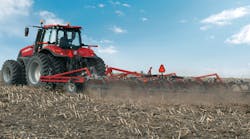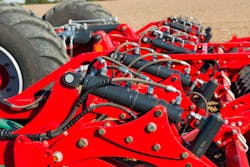Farmers need to break up compacted soil (known as hardpan) in their fields to promote root growth so crops can achieve the highest possible yield. For decades, farmers have achieved this by setting their tillage equipment to till as deeply as possible to accommodate varying but unknown depths of the compacted soil. Now, with ground-penetrating radar and GPS technology, they can map the hardpan throughout their fields. To take advantage of this information and break up the hardpan efficiently, farmers need a way to achieve accurate, variable depth control on the fly.
A linear-displacement transducer designed and manufactured by Rota Engineering Ltd., headquartered in Bury, Manchester, UK, uses linear Hall-effect to achieve the accuracy needed for agricultural applications in a package that can withstand the shock, vibration, and ambient conditions of heacy tillage equipment. The transducer mounts inside a hydraulic cylinder and is straightforward enough that it can be installed by the cylinder manufacturer, equipment manufacturer, or a dealer.
Cutaway view of a typical hydraulic cylinder shows Rota’s Hall-effect sensor inside and how the external portion of the sensor is compatible with clevis mounting.
How the Sensors Work
Hall-effect transducer senses the magnitude of a magnetic field of a magnet embedded in the cylinder’s piston and uses a microprocessor that communicates with Hall-effect chips mounted to a printed circuit board. The piston-mounted magnet causes a voltage drop when it passes over the Hall-effect chip, and the microprocessor calculates the position of the Hall-effect chip, enabling the controller to send a signal to a proportional directional valve. The transducer, therefore, provides closed-loop control between the valve and cylinder. The sensors are compact and generally do not require adding axial length to the cylinder.
Compared to other linear transducers, Hall-effect sensors provide the best combination of durability, cost, and accuracy for agricultural environments. Magnetostrictive transducers, which are often used to monitor hydraulics in stationary industrial applications, provide high positioning accuracy—generally within 0.0001 in. or better. However, this microscopic positioning accuracy is generally considered overkill for agricultural, construction, and other mobile equipment, which usually cannot justify the high cost of these sensors.
For agricultural applications, accuracy within a few hundredths of an inch is usually sufficient. Other alternatives include rotary potentiometers, which cost less but cannot withstand the agricultural environment, and rotary Hall-effect sensors, which also cost less but provide lower resolution. The latter two types also require additional linkage, mounting, and protection, which offsets their lower initial cost.
Hydraulic cylinders that control depth on the Kverneland Turbo T i-Tiller incorporate Rota Engineering’s linear Hall-effect sensors to monitor and adjust cylinder stroke position.
Controlling Tillage Depth
The Hall-effect linear transducer continuously monitors the cylinder position by sending a feedback signal to the machine’s controller, which commands the valve spool to cause the cylinder to extend, retract, or hold position. Working at the proper depth based on soil conditions—rather than unnecessarily tilling too deep throughout an entire field—eliminates over-stressing the tractor drivetrain and equipment components. It also helps minimize water and wind erosion, reduces fuel consumption, and extends equipment service life.
Generally, signals from the cylinder-position sensors in these systems are fed to a control box that transmits information in real time via Wi-Fi to a tablet in the tractor cab. In addition to providing automatic control to predetermined depths, this lets the operator make adjustments any time during operation.
Not all companies use wireless communication from the tillage implement to the tractor. Some use a wired CAN bus or ISO bus connection to the tractor where the data shows up on the terminal in the cab. Gates Mfg., Lansford, N.D., avoided the interoperability issues of ISO bus compatibility between different tractor manufacturers and uses wireless communication to a tablet as the terminal in the tractor cab.
In high-speed planting, the seedbed sets the planter speed limit. A planter riding on a consistent, level seedbed floor rides smoothly, resulting in even seed placement and uniform plant emergence. This promotes greater yield and higher profits. Improved control of tillage depth also breaks up the hardpan effectively in all soil types, which greatly increases crop yield.
In the Field
To achieve these results, Case IH uses the Rota sensor in its AFS Soil Command System. The company says the system helps producers overcome unseen challenges to unlock a field’s full agronomic potential. Right from the tractor cab, producers can control and optimize the agronomic quality of their seedbed. Internally mounted sensing technology is seamlessly integrated into the machine’s hydraulic cylinders to provide feedback to the control technology.
Because the Rota sensors are enclosed in the cylinders, they are protected from the elements that are normally associated with tillage (flying clods, debris, and soil build-up). The sensors are non-contact, which helps prevent wear. This is an advantage over other systems that use external rotary sensors with linkages. Those linkages could be subject to wear as the unit ages, and as wear increases, the accuracy of positioning is reduced.
Case IH officials say AFS Soil Command Rota sensors will be used with any Case IH tillage tool equipped with its AFS Soil Command agronomic control technology. Applications include the Case IH Ecolo-Tiger 875 disk ripper, the Tiger Mate 255 field cultivator, True-Tandem 345 and 375 disk harrows, and True-Tandem 335VT and 335 Barracuda vertical tillage tools.
The Rota sensors are also used in other agricultural equipment, including the Kverneland Turbo T i-Tiller and i-Plough, made by Kverneland Group of Norway. As part of the company’s Smart System, the operator can control depth and leveling adjustments directly from the cab of a tractor equipped with an ISO bus terminal. The system automatically sets all the implement’s hydraulic cylinders once the operator presses a button on the terminal. By controlling depth to match soil conditions, the sensor-based system provides better soil structure, minimizes wear, saves energy, and reduces fuel consumption. Officials at Kverneland explain that less than a half inch of change in working depth is equivalent to moving an extra 200 tons of soil per hectare.
For more information on Rota Engineering’s Hall-effect linear position transducers, click here.




